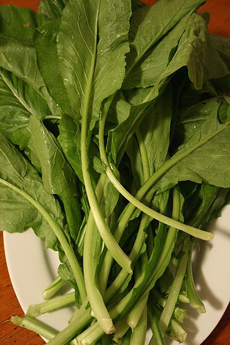TIP OF THE DAY: Try Mustard Greens
|
Nutrition experts want you to eat more cruciferous vegetables: two to three times per week, with a serving size of at least 1-1/2 cups. If you eat two cups daily, so much the better. The vegetables are not only healthy, but they’re also very filling and low in calories.
The cruciferous group includes arugula, bok choy, broccoli, Brussels sprouts, cauliflower, cabbage, collard greens, cress, horseradish, kale, kohlrabi, mizuna, radish, rapini (broccoli rabe), rutabaga, tatsoi, turnip and wasabi, a type of horseradish. Mizuna (a variety of mustard green) and tatsoi have become “designer greens” in salads at America’s finest restaurants. Pungent and peppery, mustard greens present a lighter form of the flavor of prepared mustard (which is made from the seeds of the plant). If you like mustard and haven’t yet had mustard greens, you’re in for a delightful surprise. Mustard greens, like all vegetables, are cultivated in different varieties. The supermarket variety is emerald green in color, but specialty varieties can be found in farmers markets in shades of dark red and deep purple. |
Raw mustard greens. Photo by Badagnani | |
|
|
Depending on the variety, the leaves can be rumpled or flat, with frilled, lacy or scalloped edges. You can store the fresh leaves in the fridge for four or five days. Wrap them in a paper towel and seal them in a plastic bag from which you’ve pressed out the air. How To Cook Mustard Greens Cruciferous veggies are rich in calcium, fiber, vitamins A, C, B6 and folic acid. They offer an impressive list of health benefits: The cruciferous group takes its name from cruciferae, New Latin for “cross-bearing.” The four-petal flowers in this group grow in the shape of the cross. Mustard greens originated in the Himalaya region of India, and have been cultivated for more than 5,000 years. Reminiscent of some Western African greens, mustard greens, along with turnip greens, became prominent in the cuisine of the American South in antebellum times.
|
||



